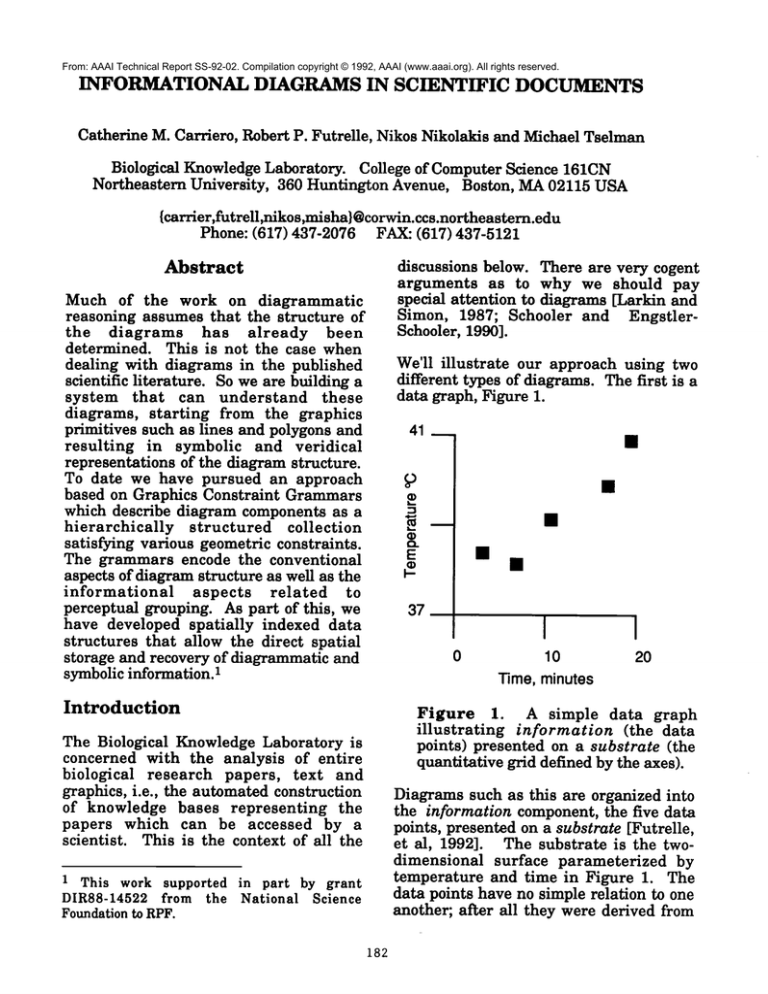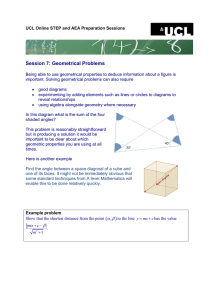
From: AAAI Technical Report SS-92-02. Compilation copyright © 1992, AAAI (www.aaai.org). All rights reserved.
INFORMATIONAL DIAGRAMS IN SCIENTIFIC
DOCUMENTS
Catherine
M. Carriero,
RobertP. Futrelle,
NikosNikolakis
and Michael
Tselman
Biological
Knowledge
Laboratory.
Collegeof Computer
Science
161CN
Northeastern
University,
360 Huntington
Avenue,Boston,MA 02115USA
{carrier,futrell,nikos~ml
sha}@corwin.ccs.northeastern.edu
Phone:(617)437-2076FAX:(617)437-5121
discussions below. There are very cogent
arguments as to why we should pay
special attention to diagrams [Larkin and
Simon, 1987; Schooler and EngstlerSchooler, 1990].
Abstract
Much of the work on diagrammatic
reasoning assumes that the structure of
the diagrams
has already
been
determined. This is not the case when
dealing with diagrams in the published
scientific literature. So we are building a
system that can understand
these
diagrams, starting
from the graphics
primitives such as lines and polygons and
resulting
in symbolic and veridical
representations of the diagram structure.
To date we have pursued an approach
based on Graphics Constraint Grammars
which describe diagram components as a
hierarchically
structured
collection
satisfying various geometric constraints.
The grammars encode the conventional
aspects of diagram structure as well as the
informational
aspects
related
to
perceptual grouping. As part of this, we
have developed spatially
indexed data
structures that allow the direct spatial
storage and recovery of diagrammatic and
symbolic information.1
We’llillustrate
our approachusingtwo
different
typesof diagrams.
Thefirstis a
datagraph,
Figure
1.
41
¢D
37
I
0
Introduction
10
Time, minutes
I
20
Figure 1. A simple data graph
illustrating
information (the data
points) presented on a substrate (the
quantitative grid defined by the axes).
The Biological
Knowledge
Laboratory
is
concernedwith the analysisof entire
biologicalresearchpapers,text and
graphics,
i.e.,theautomated
construction Diagrams such as this are organized into
of knowledgebases representingthe
the information component, the five data
papers which can be accessed by a
points, presented on a substrate [Futrelle,
scientist.
Thisis the context
of all the
et al, 1992]. The substrate is the twodimensional surface parameterized
by
temperature and time in Figure 1. The
1 Thiswork supported in partby grant
DIR88-14522
from the NationalScience data points have no simple relation to one
another; after all they were derived from
Foundation
toRPF.
182
experiment and their values are not under
the direct control of the experimenter. As
such, the data points have a high
information
content.
The scale line
structures, in contrast, are created to have
a simple structure with elements arranged
in an orderly way. They have a lower
information content.
Besides those aspects of the diagram
captured in the information / substrate
distinction, the other major ingredient of
diagram structure is the set of design
conventions in force at any time. This
description
of diagrams parallels
distinctions in natural language in which
information plays a part, e.g., in the
relation
between word length
and
frequency, along with the conventions of
any particular language at some point in
time, e.g., its lexicon and grammar.
Figure 2. A veridical diagram showing
rail shuttle service from one terminal
building to another.
The shuttle
functions include the ability to moveon
the tracks and to take on, transport
and discharge passengers and their
baggage.
Figure 2 is more complex. There is not
such a clear
distinction
between
information
and substrate.
The best
candidates for substrate elements are the
tracks and especially the ties, the short
vertical lines connecting the two tracks.
In the final analysis, the question of
whether an item is information
or
substrate may depend on the use to which
the diagram analysis is to be put. E.g., the
183
exact shape of the terminal building may
matter in some cases and may not in
others.
Graphlcs
Constraint
Grammars
A Graphics ConstraintGrammar is a
collection
of productions
of theform,
LHS ==> RHSI, RHS2, ....
The constituents
on the righthandside
may be simplegeometrical
objects
suchas
points,
lines,
polygons
or text,or theymay
be higher
levelobjects
whichappear
as the
left-hand-sides
of othergrammar
rules.In
addition,
eachrulecontains
constraints
thatmust hold betweenthe right-handside constituents
[Helm,Marriottand
Odersky,1990]. The constraintsare
typically type constraints, e.g.,
(Linep
RHS1), which says that
RHS1
must be a line, or more general geometric
constraints,
e.g.,(Parallel RHSI RHS2)
whichstatesthat the two constituents
mustbe parallel
to oneanother.
In addition, there are propagation rules
which specify
how the properties
(attribute-value pairs) of the left-hand-side
are to be computed from the properties of
the right-hand-side
constituents.
Chief
among the higher-level properties is the
bounding_box
which gives a rough
characterization
of the size, shape and
location of the left-hand-side element. For
example, in Figure 1, the bounding box for
X_scale would be computed as the smallest
rectangle enclosing the horizontal scale
line, the tick marks, their numerical labels
and the title,
"Time, minutes." This
rectangle would be propagated to Xscale
as the value of the bounding_boxattribute.
Perceptual grouping and
Generalized Equivalence
Relations
We’vepointed out that the substrate of a
diagram contains orderly arrangements of
simple items. When viewed they tend to
come together in perceptual groupings.
Most of the known perceptual grouping
processes seem to be closely tied to
equivalence relations. Objects which tend
to group perceptually
share the same
value of some simple geometrical property,
and are equivalent in that sense. The tick
marks in Figure 1 and the railroad ties in
Figure 2 group together because they are
aligned and equally spaced; these are
equivalence relations on the set of lines.
Clearly, one of the most fundamental
geometrical equivalence relations
is
coincidence. If two objects are in the same
place,
they tend to be grouped
perceptually.
A weakened form of
coincidence is near. Near is what we call a
Generalized Equivalence Relation.
It
expresses the proximity of objects. Near is
reflexive
and symmetric,
but not
transitive. The nearer two items are, the
more they tend to group perceptually.
The grammars we write depend heavily on
Generalized Equivalence Relations. They
serve to group objects at one level into
higher level objects at the next level.
Spatial Indexingand Symbolic
Graphic
Conceptually, proximity is a powerful
notion. In much of the physical world,
interactions
require proximity or even
direct physical contact. Therefore our
analysis system uses data structures that
store diagrRm constituents, both graphics
primitives and higher-level objects, in a
spatially
indexed form [Samet, 1990;
Futrelle, 1990]. The technique is very
simple and is shown in Figure 3. The grid
is much less detailed than a bitmap.
Typically a cell in the grid represents
about a lxlmm area of a published
diagrsm. Each cell in the x,y spatial array
contains a reference to any object which
touches it or covers it. In Figure 3 there
are 9 references to the circle, 6 to the
square and 7 to the triangle. Each object
contains a reference to every cell it
occupies, so once an object is discovered,
all objects near to it can be discovered
quickly.
Figure 3. Spatial indexing of three
geometrical objects. A reference to
each object is stored in every spatial
cell which the object touches. To find
objects near to the circle, the cells near
the circle’s cells are checkedand a
reference to the square is found. The
greyed line is a symbolic link between
the square and the triangle which can
be stored as a geometric object for
direct spatial access.
The spatial
indexing notion is very
powerful and can be used to directly store
symbolic information also. Let’s assume
in Figure 3 that the square and the
triangle are related by the Same_owner
relation.
We could easily place this
information in symbolic data structures
attached to both objects or indexed in an
Owner structure. But we could also place
an actual physical link into the spatial
array, an object of type Same_ownerwith
geometrical representation line as shown
in Figure 3.
The power of such an approach is that it
directly implements the "spatial storage of
information"
paradigm alluded to in
Larkin and Simon [1987]. Information
about objects is literally
stored at the
objects and relations literally
connect
objects. So if the system is looking at a
certain small set of cells it can discover
relations
about them that are stored
there. Furthermore, it can literally
184
traverse the relation line to find related
objects. This gives the entire computation
an animate vision flavor [Ullman, 1986;
Futrelle, 1990].
Semantics,
reasoning
functions
References
{Futrelle,
1990]R.P.Futrelle,
"Strategies
for DiagramUnderstanding.
Object/
Spatial
DataStructures,
Animate
Vision,
and Generalized
Equivalence,"
in
Proceedings
of the 10thICPR,IEEE
Press,
1990,pp.403-408.
and
In our work to date, we have pursued an
approach
that has been generally
successful in natural, language analysis the separation of syntax from semantics.
The initial
parsing focuses on purely
geometrical relations (syntax) without
concerning itself with semantics. This is
particularly
appropriate
for diagrams
because low-level graphical elements do
not have the arbitrary,
yet precise
meanings that words have in natural
language.
"Cat" has some serious
semantics attached to it, but the graphical
item
does not.
Its
interpretation is highly context dependent
- it could be two cars of a train, two
resistors
in a circuit drawing, or two
related tribes in an anthropological
discussion. There is no easy solution to
this interpretation
problem. The subject
area of a paper, the figure caption, the
references to the figure in the text, the
conventions of the field- all contribute to
the semantic interpretation of a diagram.
Our work to date has emphasized static
descriptions, the parse trees and semantic
frames that result from diagram analysis.
But we are looking toward analysis
techniques that include the function of the
items being analyzed. For example, in
Figure 2, the fact that a train moves on
tracks could assist
the analysis
by
decoupling the rectangle from the track
and ties substrate and identifying it as the
train.
The functionality
attached to
objects can assist the process of reasoning
about them.
[Futrelle,
etal,1992]
R.P.Futrelle,
etal,
"Understanding
Diagrams
in Technical
Doc~,ments",
IEEEComputer,
June,1992,
to appear.
[Helm,Marriott
andOdersky,
1990]
R. Helm,K. Marriott,
and M. Odersky,
"Building
VisualLanguageParsers,"
CHI
’91,ACM,New York,1991,pp. 105-112.
[Larkin
andSimon,1987]J. H. Larldn
and H. A. Simon,"Whya diagram
is
(sometimes)
worthten thousand
words,"
Cognitive
Sci.,Vol11,1987,pp.65-99.
[Samet, 1990] H. S~met, The design and
analysis of spatial data structures, (2
volumes), Addison-Wesley, Reading, MA,
1990.
[Schooler and Engstler-Schooler, 1990]
J.W. Schooler and T.Y. Engstler-Schooler,
’Verbal overshadowing of visual
memories: Somethings are better left
unsaid," Cognitive Sci., Vol. 22, 1990, pp.
36-71.
[Ullman, 1986] S. Ullman, "Visual
routines: Where bottom-up and topdownprocessing meet," in Pattern
Recognition by Humansand Machines:
Visual Perception, E.C. Schwaband
H.C. Nusba,,m eds., Vol. 2, Academic
Press, San Diego, CA, 1986, pp. 159218.
Acknowledgements
The authors wish to thank Art Miller and
others in the BKL for help on the
manuscript.
185





